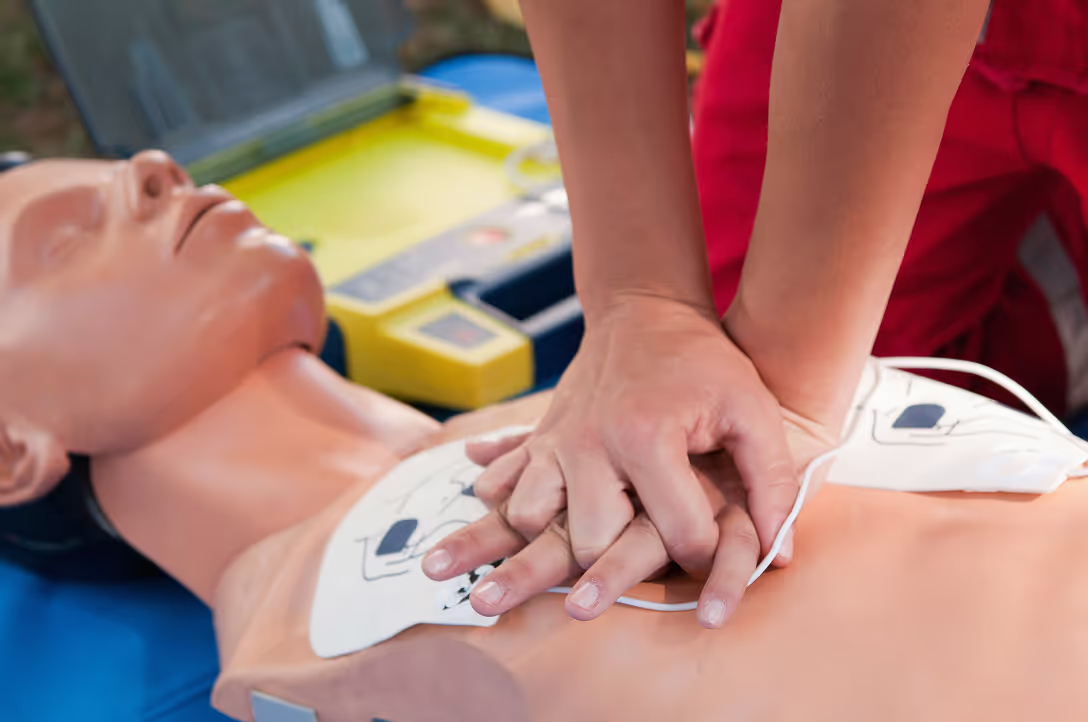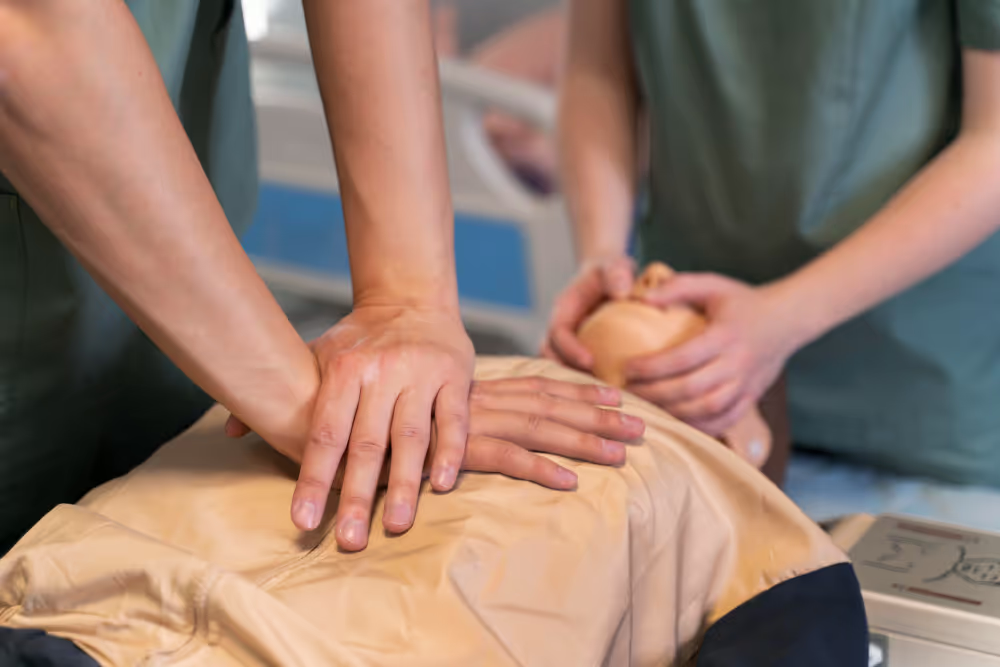Imagine you’re out for a walk in the park when you see someone lying on the ground, unresponsive. Their face is pale, and they’re not breathing. Your heart races—but you remember your CPR training. In situations like these, every minute counts. Research indicates that for every minute CPR is delayed, the chance of survival decreases by about 10%. At CPR Training Labs, we emphasize how crucial it is to understand each phase of CPR, so you can stay focused and give someone the best shot at recovery.
Below, we break down what happens in the body from the moment you start CPR—minute by minute—and discuss why your rapid response could be the difference between life and death.
What Happens in the Moments Before Cardiac Arrest?
Often, a victim loses consciousness just before cardiac arrest occurs. While loss of consciousness alone isn’t always cardiac arrest, there are a few signs that might indicate it’s imminent:
- Racing or irregular heartbeat
- Dizziness or lightheadedness
- Chest pain or discomfort
- Shortness of breath
- Nausea or vomiting
Some of these symptoms may appear seconds or hours before the heart actually stops. Once cardiac arrest begins, the victim will have no pulse, won’t be breathing normally, and will likely be unconscious.
The First Minute of CPR
When the heart stops beating effectively, the body’s organs immediately lose their supply of oxygen-rich blood. The brain, in particular, is extremely vulnerable to oxygen deprivation. Properly performed CPR circulates the remaining oxygen through the bloodstream, helping delay organ damage.
- Chest Compressions: By pressing down on the chest at 100–120 beats per minute, you manually pump blood through the body.
- Rescue Breaths (if trained and appropriate): Adding breaths helps replenish some oxygen in the bloodstream, although the primary focus is on continuous, high-quality compressions.
If CPR is initiated within the first minute of cardiac arrest, you significantly improve the victim’s chances of survival.
After Two Minutes of CPR
By this point, continuous compressions should still be pushing blood to vital organs. Administering CPR within the first two minutes can drastically improve outcomes. However, if CPR hasn’t started by now, the victim’s brain may begin to show signs of oxygen deprivation known as global cerebral ischemia.
- Why This Matters: Early intervention can limit permanent brain damage, making it crucial to begin CPR as soon as you confirm cardiac arrest.
After Four Minutes of CPR
Without CPR, the victim’s brain is likely experiencing severe ischemia. If you started CPR promptly, you might still be able to prevent serious brain injury. This is the window where bystanders’ swift action truly matters.
- Key Fact: Even if a victim is resuscitated after four minutes without CPR, the risk of irreversible brain injury is much higher. With CPR, the odds are far better.
After Six Minutes of CPR
Research shows that the brain cannot survive indefinitely without oxygen, and six minutes is often cited as a critical threshold. Without CPR, brain death is increasingly likely to set in around this time.
- The Good News: By sustaining CPR all the way through the sixth minute, you’re still delivering vital blood flow, potentially preventing total brain death.
After 10 Minutes of CPR
By the ten-minute mark with no intervention, the likelihood of total brain death becomes extremely high. However, if you’ve been performing CPR continuously:
- Keep Going: Even though survival rates drop significantly after 10 minutes, continuing CPR may yield better outcomes than stopping. There have been cases of individuals resuscitated after prolonged attempts.
After 20 Minutes and Beyond
A study in the Journal of the American Heart Association indicated that the survival rate (with functional recovery) beyond 20 minutes of CPR can be as low as a few percentage points. While the statistics are sobering, there are documented instances of successful resuscitations well beyond 20 minutes.
Can You Survive 20 Minutes Without a Heartbeat?
Surviving 20 minutes or longer without a heartbeat is rare, but not impossible. Factors that can improve these odds include:
- Immediate CPR & Defibrillation: Sustained compressions and early defibrillation with an AED drastically increase the likelihood of restoring a normal heart rhythm.
- Advanced Medical Techniques: Interventions such as medications (epinephrine, antiarrhythmics) and advanced life support systems (like ECMO) can keep oxygen flowing while medical staff work to restart the heart.
- Hypothermia: In very cold conditions, the body’s metabolism slows, which can delay brain damage and extend survival windows.
- Individual Variability: Overall health, cause of cardiac arrest, and unique physiological responses can all affect survival outcomes.
Although most cases of prolonged cardiac arrest past 20 minutes have poor outcomes, these exceptions highlight why continuing CPR remains essential until professional help arrives.
An Hour or More of CPR?
In incredibly rare circumstances, there are stories of individuals who recovered after receiving CPR for an hour or longer. Cases exist of extreme hypothermia or unique physiological conditions where prolonged CPR successfully bought enough time for advanced interventions.
- Important Note: These situations are outliers. Typically, the chance of a full neurological recovery drops sharply after the 20- to 30-minute mark. Even so, as a rescuer, it’s important to continue efforts until emergency services take over, because you never know how the victim’s body may respond.
CPR Survival FAQ
1. Can advanced medical care restart the heart after 20 minutes?
Yes, but it depends on several factors, including how quickly CPR began, whether defibrillation was administered, and the patient’s overall health. The longer the body goes without circulation, the harder it is to prevent permanent damage.
2. How vital is an AED in all this?
An AED delivers a controlled electric shock that can restore a normal heart rhythm. When used quickly, it dramatically increases survival rates—especially when combined with continuous high-quality CPR.
3. Can someone fully recover after their heart stops for an extended period?
While rare, some individuals do make full recoveries when CPR and advanced interventions are administered promptly. Factors like underlying health issues and immediate medical response play major roles.
4. What if the heart has been stopped for more than 20 minutes?
Survival rates drop significantly, but there are documented cases of resuscitation beyond this window. Immediate, persistent CPR and advanced techniques (like ECMO) can sometimes produce surprising outcomes.
5. Does the cause of cardiac arrest matter?
Yes. Cardiac arrests triggered by shockable rhythms (like ventricular fibrillation) often respond better to defibrillation. Arrests caused by respiratory issues or drug overdoses may require more specialized treatments.
Key Takeaways
- Act Immediately: Begin CPR at the first sign of cardiac arrest—every second counts.
- High-Quality Compressions: Keep them fast and deep to maintain blood flow.
- Use an AED If Available: Early defibrillation significantly raises survival odds.
- Keep Going: Even if minutes pass, continuing CPR may still improve the victim’s outcome.
- Seek Advanced Care: Prompt transport to a hospital allows for lifesaving interventions like ECMO, medications, and advanced airway management.
Ready to Learn More?
At CPR Training Labs, we offer comprehensive CPR, First Aid, and AED courses so you’ll be fully equipped to handle emergencies. Whether you need a refresher or want to earn a new certification, we’ve got you covered. Don’t wait—prepare yourself to make a lifesaving difference.








